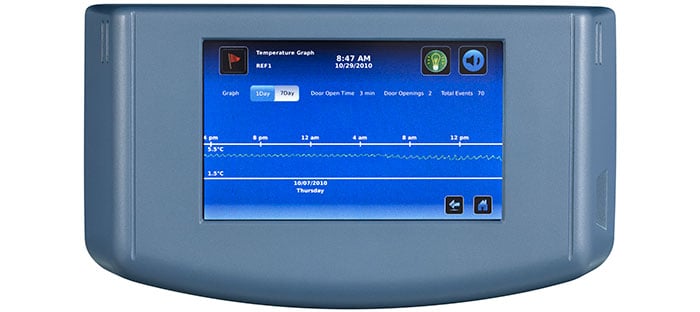
Due to increased pressure from organizations such as the Joint Commission, the Board of Pharmacy (one in each state), and the Centers for Disease Control and Prevention (CDC) healthcare providers are starting to move away from recording temperatures twice per day and towards continuous monitoring of cold storage temperatures. To do so, many facilities are investing in continuous temperature monitoring solutions, which are bringing refrigeration issues to the surface that providers never knew existed.
Continuous monitoring allows facilities to record refrigerator and freezer temperature throughout the day and night. These monitoring devices are connected by a thin wire to a temperature probe. The actual device with the display is often mounted to the front door of the refrigerator. The wire is then fed through the refrigerator door and the probe is placed in solution which mimics the temperature of the actual product being stored (medication, vaccines, etc.). Medical-grade refrigerators usually have a designated place to feed the wire into the unit so that the wire does not affect the door seal.
With the use of continuous monitoring, facilities are finding that many of the dormitory style and household refrigerators and freezers that they have been using for years are unable to maintain appropriate temperatures for the safe storage of medications and vaccines. These units tend to have hot and cold spots within the cabinet, and users will notice that frequent door openings will cause temperatures to quickly rise, potentially setting off the alarms and putting contents at risk.
We recently spoke to one of our customers who is working to get rid of all the dormitory and food grade refrigerators throughout the hospital and corresponding clinics. They shared with us that trying to convince administration of the need for medical-grade refrigeration has been a 10-year long battle. So what finally convinced them?
“The tipping point was when our outpatient clinics started losing money. By losing money, I mean having to destroy vaccines that ended up being stored out of the appropriate temperature range. We never would have known this was happening when we were only recording the temperature twice a day. Once we switched to continuous monitoring, the data was shocking.”
Medications and vaccines that are stored out of appropriate temperature range must be disposed. Not only is this a major cost implication, it also is extremely time consuming. Staff and administration are already pressed for time, and there is often a lengthy process and procedure that must be followed when disposing of medications or vaccines which were stored inappropriately. All of this could have been avoided with using proper medical-grade equipment.
Unfortunately, we hear these stories far too many times. Improper storage of refrigerated and frozen vaccines and medications is expensive, time consuming, and puts patients at risk. To learn more about how medical-grade storage can benefit your healthcare facility, contact Helmer today.



